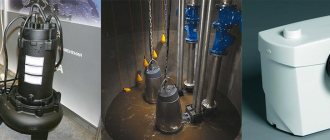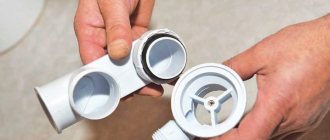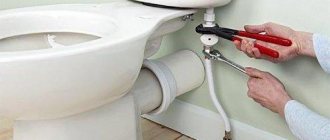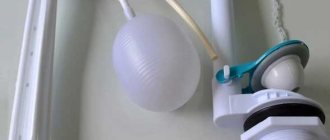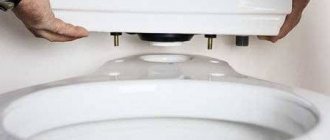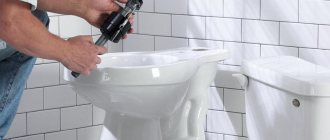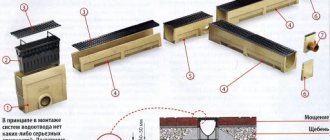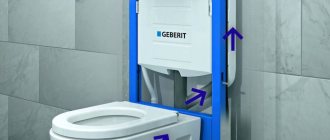A toilet is a must-have plumbing fixture for a home or apartment. This piece of plumbing equipment is quite expensive and any owner wants it to last as long as possible. And its service life depends on the internal parts of the flush cistern, called toilet fittings. Toilet fittings require constant maintenance, timely repairs, and sometimes replacement.
What the fittings consist of, how to choose them correctly and installation rules - all this is very important to know. In any photo of the toilet fittings you will be able to examine in detail all its components.
How does a toilet flush work?
As soon as you press the flush button in the toilet, a whole system of actions occurs immediately. The main actions are focused on the tank and are carried out using fittings. When draining, pressing the button causes the holding valve to open, water flows out, its level becomes lower, and the float lowers.
As soon as the valve closes again, the water supply hole is open due to the lowered float. Water is poured into the tank, raising the float with air. When the level reaches the set norm, the float closes the hole.
To prevent unpleasant odors from the sewer system, there is a siphon in the drainage system. A little clean water remains in it, which becomes a barrier to odors. If you look into the toilet you can always see a certain amount of clean water in the pipe.
Problems and their solutions
Toilet cistern noise
If a loud noise is made while filling the container with water, then the insides of the tank need to be adjusted. Most often, tanks with liquid supply from above have this problem.
Adjustment methods:
1.reducing the hole for water entry. Some tank models are equipped with this function. As the cross-section decreases, water enters the tank more slowly and the noise becomes less.
2. You can change the internal structure of the tank. To do this, take a thirty-centimeter tube made of rubber or plastic, put one end over the water inlet, and lower the other end to the bottom of the container. Through it, water will flow into the tank in an organized stream, not as a whole waterfall.
What is the difference between drain systems
Toilets differ from each other not only in appearance, but also depending on the water drainage system. Toilets may differ depending on the location of the drain pipe: oblique, horizontal, vertical drain. In addition, there is a division according to the type of water drainage: horizontal and circular.
Circular toilets are considered the most convenient in terms of flushing, since they are much quieter and flushing occurs over the entire inner surface of the bowl. When you press the button, the water comes out under the rim of the toilet, and from there it flows, washing away all the impurities.
Horizontal flushing involves direct supply of water from the barrel to the hole in the drain pipe. Thus, under strong pressure, rinsing occurs.
Vacuum toilets are considered a separate group. These are most often installed on trains. When you press the flush button in such toilets, water is released, which is drawn in along with air like a vacuum and carries away all the waste.
The pressure in such toilets is much stronger than in previous types, but they are quite noisy. With any flushing method, the main thing is to correctly adjust the toilet fittings.
What types of toilet fittings are there?
The further operation of the toilet depends on the specifics of the choice of fittings for the toilet. Having made the right choice and error-free installation, you can be confident that the toilet will last a long time. Reinforcement is divided into types according to several criteria.
According to the type of triggering the action of the drain valve, for example, the fittings can be either exhaust or push. The first involves pressing a lever, pulling a rope, or lifting a lever. The second system is the most modern and widespread. As the name suggests, it is activated by pressing the flush button.
But the main criterion by which fittings are distinguished is the system by which it operates. Based on this criterion, reinforcement is divided into:
Shut-off valves for the toilet. Its action lies in the system of closing the valve when the amount of water is filled into the tank. In this version, when the float goes down, the membrane opens the valve and vice versa when water is drawn in.
Toilet flush fittings. It also involves emergency drainage of water in addition to the usual one. When the tank overflows for any reason, excess liquid is drained. Here, flushing occurs using a piston that opens and closes the valve.
Fittings with bottom water supply. The most common type at present. Communications are hidden from view, making it look more presentable. But with such a system it is better to install good sealed gaskets.
Triton acrylic bathtubs - selection tips, location features and review of optimal modelsBidet mixer: 100 photos of modern models, recommendations for installation and selection of sizes
- Bathroom faucet - tips for choosing and the best ideas on how to choose the best model (100 photos)
Side feed fittings. The most common way for most people to supply water to the tank. Water is poured in from the side and closed with a float valve.
Conclusion
In fact, repairing an old-style toilet cistern is much easier than repairing modern options. This is due to the simplicity of the system and the reliability of all components included in it (see also the article “Valve for the drain tank - types and repair methods”).
The video in this article will clearly show some of the features of the work.
Did you like the article? Subscribe to our Yandex.Zen channel
